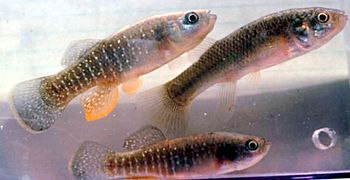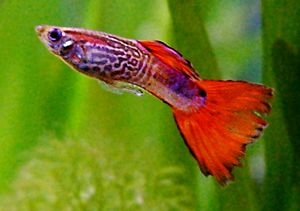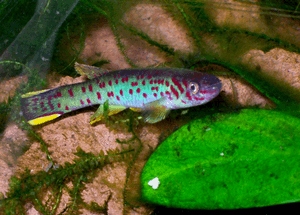Cyprinodontiformes facts for kids
Quick facts for kids Cyprinodontiformes |
|
|---|---|
 |
|
| Mummichog (Fundulus heteroclitus heteroclitus) Female (top right) and two males |
|
| Scientific classification |
|
| Kingdom: | Animalia |
| Phylum: | Chordata |
| Class: | Actinopterygii |
| (unranked): | Ovalentaria |
| Order: | Cyprinodontiformes L. S. Berg, 1940 |
| Type species | |
| Cyprinodon variegatus Lacépède, 1803
|
|
| Suborders | |
|
Aplocheiloidei |
|
| Synonyms | |
|
Microcyprini Regan, 1909 |
|
Cyprinodontiformes (say: Sip-rin-oh-DON-tih-form-eez) are a group of mostly small, freshwater fish. They are also known as toothcarps. Even though they are called "toothcarps," they are not closely related to true carp fish. Many popular aquarium fish, like killifish and live-bearers (such as guppies and mollies), belong to this group!
These fish are a type of ray-finned fish, which means their fins are supported by bony spines. They are related to Atheriniformes, another group of fish.
Fish in the Cyprinodontiformes order have different ways of having babies:
- Some are egg-laying (called oviparous). This means the mother lays eggs, and the babies hatch from the eggs outside her body.
- Others give live birth. There are two types of live birth:
- Ovoviviparous fish keep the eggs inside their body until they hatch. The babies then come out alive.
- Viviparous fish also give live birth, but the babies develop inside the mother without an eggshell, getting nutrients directly from her.
Contents
What Do These Fish Look Like?
Most fish in this group are small to medium-sized. They usually have small mouths, large eyes, one fin on their back (called a dorsal fin), and a rounded tail fin (called a caudal fin).
The biggest fish in this group is the cuatro ojos (Anableps dowei), which can grow up to 34 centimeters (about 13 inches) long. The smallest is the least killifish (Heterandria formosa), which is only 8 millimeters (about 0.3 inches) long when it's an adult!
Where Do They Live?
Some of these fish are amazing because they can live in very tough places. You might find them in:
- Salty water
- Very warm water
- Water that is heavily polluted
- Rainwater pools that don't have many minerals and are acidic from decaying plants
- Isolated spots where no other types of fish can survive
What Do They Eat?
Most Cyprinodontiformes are carnivores, meaning they eat other animals. They often swim near the surface of the water. This is where the water has more oxygen, which helps them survive in difficult environments.
Scientists have found that these fish often eat insects, worms, and small water creatures like crustaceans. Some, especially the pupfishes (from the family Cyprinodontidae), also eat plants. For example, the American Flag Fish is famous in aquariums for eating a lot of algae, even though most fish in this group don't eat plants!
Killifish also get special colors for their bodies from chemicals found in pollen. They get these chemicals by eating insects that have pollen on them from the water's surface.
Types of Cyprinodontiformes

This order includes many different families of fish. Here are some of the main groups:
- Aplocheiloidei (all lay eggs):
- Aplocheilidae: These are the Asian killifishes.
- Nothobranchiidae: These are the African killifishes.
- Rivulidae: These are the New World killifishes.
- Cyprinodontoidei (includes both egg-laying and live-bearing fish):
- Funduloidea group:
- Profundulidae: Central American killifishes (lay eggs).
- Goodeidae: Known as splitfins (mostly give live birth).
- Fundulidae: Topminnows and North American killifishes (lay eggs).
- Valencioidea group:
- Valenciidae: Mediterranean killifishes (lay eggs).
- Cyprinodontoidea group:
- Cyprinodontidae: These are the pupfishes (lay eggs).
- Poecilioidea group:
- Anablepidae: These include the interesting four-eyed fishes (mostly give live birth).
- Poeciliidae: This family includes many popular livebearers like guppies, mollies, and platies (some lay eggs, some give live birth).
- Funduloidea group:
See also
 In Spanish: Cyprinodontiformes para niños
In Spanish: Cyprinodontiformes para niños


